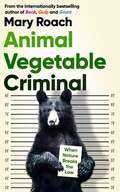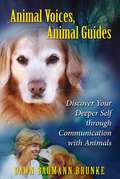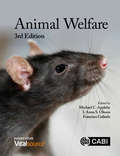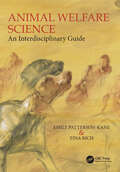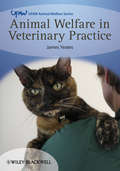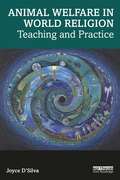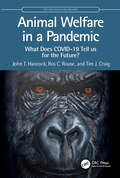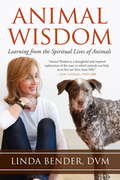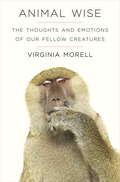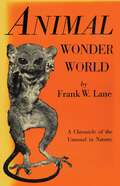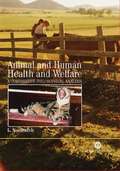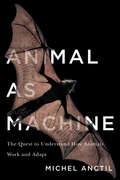- Table View
- List View
Animal Ultimate Handbook: The Need-to-Know Facts and Stats on More Than 200 Animals (DK's Ultimate Handbook)
by DKTake a tour of the animal kingdom and learn everything there is to know about the wildlife that inhabits the Earth in this complete guide to animals.Introducing Animal Ultimate Handbook, the latest title in DK&’s Ultimate Handbook series which takes you on a journey of a lifetime as you discover some of the world&’s most incredible mammals, fish, reptiles, amphibians, and insects. Whether you are trekking through the hot and humid rainforest, exploring the dark depths of the ocean, or climbing the snow-capped, icy mountains, you will learn all about some of the extraordinary animals that live on Earth.This ultimate kids&’ factbook includes must-know facts and stats about more than 200 species of animal, from where they live to how they communicate with one another, and much, much more. With modern, detailed illustrations and unique information confirmed by our own animal expert, this book is perfect for inquisitive, young animal lovers.Explore the animal kingdom like you&’ve never done before and discover:-Features captivating, detailed illustrations of the animal kingdom-Full of unique and interesting facts and stats on more than 200 different animals-Special features about animals diets, habitats, communication, and more-Full of detailed illustrations, engaging information and essential facts and statistics about more than 200 animal speciesWith this highly engaging animal book, you will learn to tell your dolphins from your porpoises, predators from your prey, and carnivores from your herbivores. The handbook style format allows children to be introduced to the topic of animals in a way that is detailed, without being overwhelming or talking down to them. The interactive &‘Head to head!&’ pages feature two animals against one another in a category such as speed or strength, analyzing which one would emerge victoriously and highlighting the amazing features of different animals. DK&’s Animal Ultimate Handbook is ideal for sparking curiosity and is certain to amaze any child aged 6+ interested in the animals, doubling up as a must-have volume for parents, caregivers and educators seeking a fun, non-fiction animal book for children. So if you love the outdoors and want to know everything about the fantastic wildlife that live there, then this book will make the perfect companion and a great addition to your bookshelf.
Animal Vegetable Criminal: When Nature Breaks the Law
by Mary RoachWhat&’s to be done about a jaywalking moose? A grizzly bear caught breaking and entering? A murderous tree? We&’ve never been good at sharing the planet… In the past, when wild animals &‘broke the law&’, they might be given lawyers and put on trial. But now, what&’s the solution when nature gets in our way? In this fresh, funny and thoroughly researched book, dive into the weird and wonderful moments when humanity and wildlife bump up against one another. Follow Mary Roach as she explores laser scarecrows, robo-hawks, human-elephant conflict specialists and monkey impersonators. Travel to the bear-busy back alleys of Aspen, the gull-vandalized floral displays at the Vatican and leopard-terrorized hamlets in the Himalayas, and discover hope for compassionate coexistence.
Animal Vocal Communication
by Morton Eugene S.This book will be a landmark text for all those interested in animal communication. Animal Vocal Communication explicitly avoids human-centred concepts and approaches and links communication to fundamental biological processes instead. It offers a conceptual framework - assessment/management - that allows us to integrate detailed studies of communication with an understanding of evolutionary perspectives. Self-interested assessment is placed on par with the signal production (management) side of communication, and communication is viewed as reflecting regulatory processes. Signals are used to manage the behaviour of others by exploiting their active assessment. The authors contend that it is this interplay between management and assessment that results in the functioning and evolution of animal communication; it is what communicative behaviour accomplishes that is important, not what information is conveyed.
Animal Voices, Animal Guides: Discover Your Deeper Self through Communication with Animals
by Dawn Baumann BrunkeHow to connect with animal guides to expand individual and planetary awareness • Reveals techniques for exploring dreams, shamanic journeys, healing, and shapeshifting with animals • Presents words of wisdom from cats, dogs, horses, llamas, rabbits, ravens, bears, and even insects As companions, helpers, and spiritual guides, animals have always held a special relationship with humans. As we access our natural ability to communicate with animals, we cannot help but open ourselves more profoundly to life, other human beings, and our own deep nature--the essence of who we really are. Animal Voices, Animal Guides presents a wide variety of ways in which we can tune in to the “universal language” of all life and reconnect with the animal kingdom in more conscious, meaningful ways. Through myths, shamanic journeys, and dreams we meet our power animals, spirit animals, and wise animal guides. The exercises, meditations, stories, and experiments included are designed to help us tune in to the subtle whispers of nature and expand our awareness. We learn what sled dogs have to teach us about teamwork, how llamas see themselves as healers of the world, and how it would feel to inhabit the skin of a shark. Filled with advice from animal communication professionals and actual conversations with animals, Animal Voices, Animal Guides is an invitation to explore our inner ways of knowing. When we learn how to use all our senses to listen to animals, we will find out how to listen to our authentic self as well.
Animal Wayshowers: The Lightworkers Ushering In 5D Consciousness
by Tammy Billups• Explains how animals that live alongside humans are lightworkers helping to raise the vibration of collective consciousness and aid in humanity&’s ascension process• Shares example stories of incredible animal Wayshowers from around the world whose actions and sacrifices on behalf of their human companions changed them all for the better• Offers meditations, rituals, and transformational soul practices to embrace 5D frequencies, intuit heart intelligence, connect to the Higher Self, and heal the shadowAnimals are natural holders of 5D consciousness. The extraordinary animals who have chosen, at a soul level, to live alongside humans are lightworkers on the front lines of the animal kingdom&’s mission to help people to heal, evolve, and assist in raising the vibration of the planet and collective consciousness to 5D.As Tammy Billups reveals, once we become aware of the soul path of our animal companions, we are then able to connect with them soul-to-soul, not only supporting their soul missions but also finding the healing we need to let go of 3D reality. Sharing stories of incredible animal wayshowers from around the world, she explores the many levels of service your beloved animal friends are providing you every day, including during disasters, storms, and pandemics. She shows how they help shoulder the psychological and emotional burdens we are not yet capable of holding on our own and show us the way back to our own hearts. The author offers meditations, rituals, and exercises for applying the teachings of the animal stories shared, including transformational soul practices to embrace 5D frequencies, intuit heart intelligence, connect to the Higher Self, and heal the shadow. Offering ways to embrace and emulate the soul teachings of our animal companions, Tammy Billups shows that, by honoring animals as courageous guides on our ascension to 5D consciousness, we too can become wayshowers in our own right
Animal Welfare
by Richard Bennett Paul Thompson David Fraser Georgia Mason Peter Sandøe Michael Appleby Anna Olsson Ignacio Viñuela-Fernández Michael Cockram Paul Hemsworth Joy Mench Ilias Kyriazakis Linda Keeling Marek Spinka Birte Nielsen Andreas Steiger Andrew Butterworth Francisco Galindo Barry Hughes Paul Hocking Dominique Blache Alain Boissy Bryan JonesThe welfare of animals continues to increase in recognition and concern throughout the world, with more and more research in the field offering new insights into the optimal conditions and treatment for the animals we live and work with. Providing a broad introduction to the key topics in the welfare of animals large and small, farm and companion, wild and zoo, this fully updated textbook covers ethics, animal pain and injury, health and disease and social conditions, welfare issues and problems, their assessment, and solutions. With contributions from renowned international experts Animal Welfare, 2nd Edition is an essential resource for students and researchers in animal and veterinary sciences.
Animal Welfare
by Richard Bennett Paul Thompson David Fraser Georgia Mason Clare Palmer Peter Sandøe Christine Nicol Daniel Weary Michael Appleby Anna Olsson Ignacio Viñuela-Fernández Michael Cockram Paul Hemsworth Joy Mench Ilias Kyriazakis Linda Keeling Marek Spinka Birte Nielsen Francisco Galindo Barry Hughes Dominique Blache Alain Boissy Bryan Jones Dr Andrew Butterworth Charlotte C. Burn Grahame J. Coleman Richard B. D’Eath Ian J.H. Duncan Cathy M. Dwyer Paul Flecknell Paul M. Hocking Stella Maris Huertas Joergen B. Kjaer Ute Knierim Shane K. Maloney Professor Michael Mendl Ruth C. Newberry Edmond A. Pajor Jeff Rushen Sally L. Sherwen Claudia Terlouw Bert Tolkamp Natalie K. Waran Francoise Wemelsfelder Nadja Wielebnowski Hanno WürbelUpdated and revised, this bestselling textbook continues to provide a broad introduction to the key topics in the welfare of animals both large and small, farm and companion, wild and zoo. It retains all the popular features of the previous editions with coverage of key issues such as ethics, animal pain and injury, health and disease, social conditions, and welfare dilemmas and problems. Importantly, it also offers practical advice for welfare assessment, with a full section dedicated to the implementation of solutions. The third edition: - Contains many more examples of welfare issues in different countries, particularly the implications for smallholders as well as larger scale agriculture - Covers fish welfare as well as welfare of amphibians, reptiles and invertebrates - Includes concepts of positive emotion and other positive aspects of welfare - Focuses on animal welfare and sustainability - Includes an integrated ebook with additional material and videos With contributions from renowned international experts and a new editorial team, Animal Welfare, 3rd Edition is an essential resource for students and researchers in animal and veterinary sciences and other disciplines considering the science and practice of animal welfare, and for practitioners and decision-makers worldwide.
Animal Welfare Science: An Interdisciplinary Guide
by Emily Patterson-Kane Tina RichAnimal welfare as a concept and practice is important to many disciplines and professions. From blue skies scientists to front line animal rescue, there is a need for this textbook, which distils and interprets the core concepts and language of animal welfare science.Coverage includes the main theories and why we needed them; practical advice for how to assess animal welfare; illustrative examples of different species and the importance of their interactions; and the stresses and strains experienced across an increasingly diverse workforce. Foundational knowledge is combined with real-world examples and recent advances to communicate the content and spirit of this unique field.This accessible text is designed to support tertiary animal welfare curricula but is also relevant to the study of human–animal interactions, anthropology, and related fields. It provides a jumping-off point for many areas of knowledge and application for anyone interested in how animal welfare and science intersect. Animal Welfare Science: An Interdisciplinary Guide was created to provide an informational grounding that fosters competency, credibility, and the confidence to engage with peers across the animal welfare space. It also provides an overview of the career landscape with practical advice about the challenges and pressure points that you may encounter. Along with copious color illustrations, bullet points, text boxes, thought experiments, tables, and links to video and other online resources aid accessibility.
Animal Welfare in Animal Agriculture: Husbandry, Stewardship, and Sustainability in Animal Production
by Bernard E. Rollin Fuller W. Bazer Wilson G. PondWhat constitutes animal welfare? With animals being used for companionship, service, research, food, fiber, and by-products, animal welfare is a topic of great interest and importance to society. As the world's population continues to increase, a major challenge for society is the maintenance of a strong and viable food system, which is linked to t
Animal Welfare in Islam
by Al-Hafiz Basheer Ahmad MasriThis pioneering modern classic examines the Islamic principles of kindness and compassion toward animals. It compares animal sacrifice as practiced by the world's major religions and highlights the ethical issues that the mass production of meat raises, advocating alternative ways to produce halal meat in an appropriate manner. Basheer Ahmad Masri (1914-1992) was the first Sunni Imam of the oldest purpose-built mosque in Britain, the Shahjahan Mosque in Woking. For six years he served as a joint editor of the monthly Islamic Review. He was fluent in English, classical Arabic, Urdu, Hindustani, Punjabi, and Kiswahili.
Animal Welfare in Veterinary Practice
by James YeatesA practical guide to help veterinarians improve the welfare of their patients in their everyday work. A concise and accessible introduction to welfare that is both interesting and valuable in practice.The book describes ways to evaluate patients, develop in-practice quality of life assessments, resolve difficult clinical dilemmas, and turn good decisions into real welfare outcomes. It reviews available scientific information, legal issues and ethical dilemmas, and relates these to everyday case studies throughout. It provides ways for all veterinary professionals to develop their animal welfare understanding, without assuming prior knowledge, while advancing the wisdom and abilities of experienced practitioners.Key features:Presents practical and realistic methods for working with owners to improve patients' welfare within the constraints of everyday practice.Provides useful advice for work within many legal jurisdictions.Includes summaries of research, vital references, and further reading sources.Key points are recapped at the end of each chapter.Suitable for all those working in the veterinary and related professions, including veterinarians, veterinary nurses, animal welfare scientists, animal behaviourists, paraprofessionals and lay staff.Published as a part of the prestigious Wiley-Blackwell - UFAW Animal Welfare series. UFAW, founded 1926, is an internationally recognised, independent, scientific and educational animal welfare charity. For full details of all titles available in the UFAW series, please visit www.wiley.com/go/ufaw.
Animal Welfare in World Religion: Teaching and Practice
by Joyce D'SilvaThis unique and readable book examines the relationship between religion and animal welfare, taking a detailed dive into the teachings and practices of the major world religions. While there are many books expounding the beliefs of the major religions and many about the rights and welfare of animals, there are few linking the two. With each chapter focusing on one of the five major religions – Judaism, Christianity, Islam, Hinduism and Buddhism – the book explores the beliefs and practices which drive our relationship with and treatment of animals. The book draws on the scriptures of the major faiths and includes the voices of leading historical religious figures and contemporary faith leaders. In doing so, it compares the teachings of old with contemporary practices and showcases the impact of the major religions on both the protection and exploitation of animals, from running animal sanctuaries, to participating in or condoning cruel sports and factory farming. Importantly, the book also includes a chapter looking beyond the major world religions, where it examines a wider range of beliefs and practices, including Indigenous peoples from the USA and Australia, Jainism, Sikhism and Rastafarianism, to provide fascinating insights into another range of beliefs and views on the human-animal relationship. Overall, this book challenges and encourages religious leaders and followers to re-examine their teachings and to prioritise the well-being of animals. This book is essential reading for those interested in the role of religion in animal welfare, human-animal studies, and animal welfare and ethics more broadly.
Animal Welfare in a Changing World
by Temple Grandin David A. Fennell Tomas Norton Paul C. Paquet Elly Hiby Mark Jones Conor Ryan Philip Lymbery Dr Andrew Butterworth Rebecca Aldworth Shelley M. Alexander Regina Asmutis-Silvia Panayiotis Panos Azmanis Prof Daniel Berckmans Lotta Berg Harry Blokhuis Xavier Boivin Dr John Bradshaw Prof. Victoria Braithwaite Stijn Bruers Henry Buller Joyce D’Silva Sarah Dolman Chris Draper Dr Charles Foster Taryn Glass Adam Hart Dr Sophia Hepple Kristof Hermans Dr Miel Hostens Michael J Kuba Miriam Martin Geert Opsomer Maria Panagiotopoulou Mark Simmonds Kalliopi Stara Rigas Tsiakiris Dr Bonny Ranst Paul Whittington Dr James YeatesContemporary and challenging, this thought-provoking book outlines a number of the key dilemmas in animal welfare for today's, and tomorrow's, world. The issues discussed range from the welfare of hunted animals, to debates around intensive farming versus sustainability, and the effects of climate and environmental change. The book explores the effects of fences on wild animals and human impacts on carrion animals; the impacts of tourism on animal welfare; philosophical questions about speciesism; and the quality and quantity of animal lives. The welfare impacts of human-animal interactions are explored, including human impacts on marine mammals, fish, wildlife, and companion and farm animals. Animal Welfare in a Changing World provides: Concise, opinion-based views on important issues in animal welfare by world experts and key opinion leaders. Pieces based on experience, which balance evidence-based approaches and the welfare impacts of direct engagement through training, campaigning and education. A wide-ranging collection of examples and descriptions of animal welfare topics which outline dilemmas in the real world, that are sometimes challenging, and not always comfortable reading. This is a 'must-read' book for animal and veterinary scientists, ethologists, policy and opinion leaders, NGOs, conservation biologists and anyone who feels passionately about the welfare of animals
Animal Welfare in a Changing World
by Temple Grandin David A. Fennell Tomas Norton Paul C. Paquet Andrew Butterworth Elly Hiby Mark Jones Conor Ryan Philip Lymbery Rebecca Aldworth Shelley M. Alexander Regina Asmutis-Silvia Panayiotis Panos Azmanis Prof Daniel Berckmans Lotta Berg Harry Blokhuis Xavier Boivin Dr John Bradshaw Prof. Victoria Braithwaite Stijn Bruers Henry Buller Joyce D’Silva Sarah Dolman Chris Draper Dr Charles Foster Taryn Glass Adam Hart Dr Sophia Hepple Kristof Hermans Dr Miel Hostens Michael J Kuba Miriam Martin Geert Opsomer Maria Panagiotopoulou Mark Simmonds Kalliopi Stara Rigas Tsiakiris Dr Bonny Ranst Paul Whittington Dr James YeatesContemporary and challenging, this thought-provoking book outlines a number of the key dilemmas in animal welfare for today's, and tomorrow's, world. The issues discussed range from the welfare of hunted animals, to debates around intensive farming versus sustainability, and the effects of climate and environmental change. The book explores the effects of fences on wild animals and human impacts on carrion animals; the impacts of tourism on animal welfare; philosophical questions about speciesism; and the quality and quantity of animal lives. The welfare impacts of human-animal interactions are explored, including human impacts on marine mammals, fish, wildlife, and companion and farm animals. Animal Welfare in a Changing World provides: Concise, opinion-based views on important issues in animal welfare by world experts and key opinion leaders. Pieces based on experience, which balance evidence-based approaches and the welfare impacts of direct engagement through training, campaigning and education. A wide-ranging collection of examples and descriptions of animal welfare topics which outline dilemmas in the real world, that are sometimes challenging, and not always comfortable reading. This is a 'must-read' book for animal and veterinary scientists, ethologists, policy and opinion leaders, NGOs, conservation biologists and anyone who feels passionately about the welfare of animals
Animal Welfare in a Pandemic: What Does COVID-19 Tell us for the Future? (CRC One Health One Welfare)
by John T. Hancock Ros C. Rouse Tim J. CraigAnimal Welfare in a Pandemic explores the impact of COVID-19 on a wide array of animals, from those in the wild to companion and captive animals. During the height of the pandemic, a range of animals were infected, and many died, but this was hard to predict, even using up-to-date bioinformatics. Lockdowns around the world had, and continue to have, a major effect on animals’ welfare, influencing pet ownership and care, as well as impacting on the work of conservation institutes due to the lack of visitors and funding and lack of tourist presence in the wild which impacted on anti-poaching efforts. Some of the vast amount of personal protection equipment (PPE) that was distributed was discarded, creating both dangers and occasional opportunities for wild animals. With the rollout of human vaccines, some countries started developing animal vaccines, only some of which were deployed. In summary, the pandemic had a wide-ranging influence on animal welfare around the world. This is reviewed to highlight what can be learned to protect and enhance animal welfare in future epidemics/pandemics, and contribute to a genuinely One Health approach where the health and welfare of both humans and animals are considered holistically.This book is authored by members of the University of the West of England, Bristol, who span a range of expertise in Biological Sciences, Social Sciences, Animal Welfare, and Ethics.
Animal Welfare, 3rd Edition
by Michael C. Appleby I. Anna S. OlssonUpdated and revised, this bestselling textbook continues to provide a broad introduction to the key topics in the welfare of animals both large and small, farm and companion, and wild and zoo. It retains all of the popular features of the previous editions and covers key issues such as ethics, animal pain and injury, health and disease, social conditions, and welfare dilemmas and problems. Importantly, it also offers practical advice for welfare assessment and a full section dedicated to the implementation of solutions. The third edition: - Contains many more examples of welfare issues in different countries, particularly the implications for smallholders as well as larger scale agriculture - Covers fish welfare as well as the welfare of amphibians, reptiles, and invertebrates - Includes concepts of positive emotion and other positive aspects of welfare - Focuses on animal welfare and sustainability - Includes an integrated ebook with additional material and videos With contributions from renowned international experts and a new editorial team, Animal Welfare 3E is an essential resource for students and researchers in animal and veterinary sciences and other disciplines considering the science and practice of animal welfare as well as for practitioners and decision-makers worldwide.
Animal Welfare: Understanding Sentient Minds and Why It Matters (UFAW Animal Welfare #3)
by John WebsterAnimal Welfare An Accessible Overview of the Concept of Sentience Throughout the Animal Kingdom and Why It Matters to Humans Animal Welfare explores the concept of sentience and the development of sentient minds throughout the animal kingdom. The work provides improved definitions and analysis of the ideas of sentience, cognition, and consciousness, along with evidence of advanced mental formulation in birds, fish, and invertebrates. Considerations between humans and animals are also discussed, such as outcome-based ethics in relation to humans’ duties of care and the rights and wrongs of domestication. The work is divided into three parts and covers key topics such as: Specifics of animal sentience, from pain and suffering, to fear and dread, all the way to animals’ social life and the comfort/joy/hope/despair they experience What we know about the sentience of different classes of animals in the waters, air, savannah/plains, and forests Considerations on human interactions based on animal sentience, including death (killing), animal farms, animals in laboratories, wild animals in captivity, and animals in sports and entertainment Analysis on what humans can learn from animals based on what we know about their varying levels of sentience Animal Welfare serves as an invaluable analysis of animal sentience for students, teachers, and professionals directly involved in the study, teaching, and applications of animal behavior, motivation, and welfare. Thanks to the wide-ranging implications of animal sentience, the work will also appeal to everyone with a broader interest in animal behavior and human/animal interactions.
Animal Wisdom
by Andrew Harvey Linda Tucker Linda BenderHow is it that pets are able to travel thousands of miles through unknown territory to reunite with their beloved humans? How can dogs detect cancer with up to a 98 percent accuracy rate, and foresee epileptic or diabetic seizures in their owners? How do animals seem to know an earthquake is coming long before the world's best seismologists? In Animal Wisdom, veterinarian and animal advocate Linda Bender offers a wealth of amazing stories and research-based evidence indicating animals have deeply perceptive--even extrasensory--abilities. She shows us that animals are extremely perceptive, intuitive, and psychic and provides step-by-step practices for honing your natural ability to communicate with them, so that you too can learn to understand their urgent messages about peace, happiness, and the future of the planet. Animal Wisdom is for animal lovers and anyone who seeks a deeper, more spiritual connection to these beautiful creatures.From the table of contents:Foreword by Linda TuckerPART I: The Fabric of CreationChapter 1: The Ecology of ParadiseChapter 2: How Can We Know What Animals Are Thinking and Feeling?PART II: What Animals Want Us to KnowChapter 3: You Are LovedChapter 4: You Are Already Living in ParadiseChapter 5: You Don't Have to Figure Everything OutChapter 6: Dying Isn't BadPART III: The Connection of All CreaturesChapter 7: How to Connect Telepathically with Animals: A Practical GuideChapter 8: The Animals Speak for ThemselvesChapter 9: Heeding the Cries of the Nonhuman WorldAfterword by Andrew HarveyFrom the Trade Paperback edition.
Animal Wise
by Virginia MorellNoted science writer Virginia Morell explores the frontiers of research on animal cognition and emotion, offering a surprising and moving exploration into the hearts and minds of wild and domesticated animals. Did you know that ants teach, earthworms make decisions, rats love to be tickled, and chimps grieve? Did you know that some dogs have thousand-word vocabularies and that birds practice songs in their sleep? That crows improvise tools, blue jays plan ahead, and moths remember living as caterpillars? Animal Wise takes us on a dazzling odyssey into the inner world of animals, from ants to elephants to wolves, and from sharp-shooting archerfish to pods of dolphins that rumble like rival street gangs. With 30 years of experience covering the sciences, Morell uses her formidable gifts as a story-teller to transport us to field sites and laboratories around the world, introducing us to pioneering animal-cognition researchers and their surprisingly intelligent and sensitive subjects. She explores how this rapidly evolving, controversial field has only recently overturned old notions about why animals behave as they do. She probes the moral and ethical dilemmas of recognizing that even "lesser animals" have cognitive abilities such as memory, feelings, personality, and self-awareness--traits that many in the twentieth century felt were unique to human beings. By standing behaviorism on its head, Morell brings the world of nature brilliantly alive in a nuanced, deeply felt appreciation of the human-animal bond, and she shares her admiration for the men and women who have simultaneously chipped away at what we think makes us distinctive while offering a glimpse of where our own abilities come from.
Animal Wonder World: A Chronicle of the Unusual in Nature
by Frank W. LaneThis is a charming series of essays on animal behavior, written in 1951 by the note British science writer Frank W. Lane, reveals obscure and fascinating oddities of animal behavior. The clear, logical explanation behind each bizarre happening grounds the observations in scientific research, and provides modern readers insight on mid-century scientific field methodology.Here are some of the cases featured in this fantastic compilation: Do bees tell time and tell each other of honey locations? Can game animals dodge bullets? Have fish an ear for music? Do birds hitch hike on each other&’s backs? These questions and thousands of others are answered with scientific proof.Natural history fans, history of science buffs, and explorers of nature will find hours of fascinating reading within. A true mine of conversational material and arbiter of game controversies!
Animal World (Questions and Answers)
by Arcturus PublishingAnimal World is packed full of amazing images and fascinating facts about the magnificent creatures that inhabit the earth. Explore the great diversity of the animal kingdom, from lions to lizards and elephants to eagles - Readers can look forward to learning about them all!
Animal Worlds: African Animals
by Joann Early MackenSimple text introduces animals that live in the African grasslands, such as the zebra, hyena, vulture, leopard, and gnu.
Animal and Human Health and Welfare
by Lennart NordenfeltScientists within human and animal science have extensively discussed the philosophy of medicine, but never have both sides communicated on their concepts of health, quality of life and welfare, with each other. This book aims to help clarify the difficult but central notions of health and welfare by comparing the human and animal variants of these concepts. Split into three parts this book starts by presenting a background of some of the major theories of human health and welfare, followed by a detailed discussion of theories on animal welfare and health. While the final part of the book tests a comprehensive conceptual framework of a holistic kind, which focuses on the individual's ability to achieve its vital goals.
Animal as Machine: The Quest to Understand How Animals Work and Adapt
by Michel AnctilThrough the ages natural historians have puzzled over how animals work, wavering between a vitalist belief in a soul animating bodily functions and a mechanistic outlook in which animal body parts are seen as pieces of organic machinery.Animal as Machine explores the life, work, and ideas of scientists who, branding themselves as physiologists, subscribed to mechanistic concepts to explain how animals acquire and process food, breathe, circulate their blood, and sense their environment. As medical physiology thrived in the nineteenth century, zoologists struggled to forge their own distinctive physiology predicated on understanding animal functions in a context of environmental adaptation and evolutionary forces. Physiological schools with distinct emphases that shaped their outlook sprang up around the world. Dividing their time between fieldwork in marine stations and laboratory experimentation, animal physiologists stood in awe of the diversity and ingenuity of the functional strategies by which animals survived.Animal as Machine tells a remarkable and insightful story of the larger-than-life personalities and gripping historical episodes that marked the emergence and blossoming of animal physiology.
Animal at Large (Mysteries on Zoo Lane #2)
by Patricia Reilly GiffA missing animal at the zoo and strange noises coming from her backyard can mean only one thing for Tori: she's got a mystery to solve!Tori loves living on Zoo Lane with her family. Who else gets to live at a zoo--and with her cousin Sumiko visiting from Tokyo soon, this is shaping up to be the best summer ever! But when rumors of a missing animal start to spread, Tori wants to help . . . except she doesn't know which creature is on the loose. An ostrich? A little frog? There's also a strange noise coming from her backyard. It almost sounds like someone is calling her name! Tori is on the case.In this second book in the illustrated Mysteries on Zoo Lane series, two-time Newbery Honor author Patricia Reilly Giff has crafted a charming story about conservation, animal care, friendship, and problem-solving. In touch with the programs and initiatives that today's zoos are undertaking, Giff provides readers with a fresh look at the work of zoologists. Charming line artwork by Abby Carter appears throughout and keeps the story upbeat.

